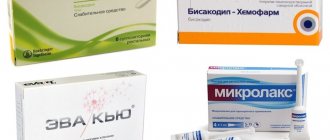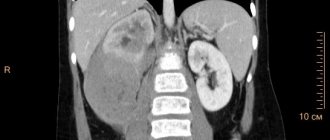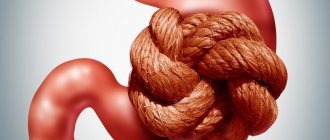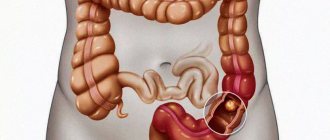Author, editor and medical expert - Klimovich Elina Valerievna.
Number of views: 453 808
Last updated: 10/29/2021
Average reading time: 17 minutes
- Therapeutic diet
Constipation (from the Latin constipatio - accumulation, accumulation) can occur in a child at any age1, 3. It is associated with a slowdown in the movement of feces through the intestines3, 4. This is one of the most common “children’s” problems4, but many parents do not recognize it or They believe that a child at 3 or 4 years old will “go away on its own”, without medical help. Some parents do not consult a doctor on time3, 5 because they cannot understand whether the baby goes to the toilet often enough, whether the density and volume of feces is normal1, 3, 5.
Up to contents
Constipation is a very common problem in children. Why?
With the start of complementary feeding, babies' stools most often improve.
This is due to the introduction of fiber into the child’s diet, as well as an increase in the child’s physical activity. But after 1 year, the number of children suffering from constipation begins to increase again. This is due to giving up breastfeeding, switching to solid foods, and reducing the amount of water in the diet. Approximately every fifth child suffers from constipation after one year. How to deal with this problem? For your health - recommendations from the pediatrician of the ENT Plus clinic, a doctor of the highest category, Anna Gennadievna Marakulina.
Signs of the disease
Source: t.tomsickova / Depositphotos
Clinical manifestations of constipation are varied. They become most pronounced with prolonged constipation and are:
- Bowel movements less than 2 times a week;
- The stool comes out heavily, its substance is dry, hard, consisting of many pieces;
- Defecation is accompanied by pain;
- The child may feel that some of the contents have not come out;
- Abdominal pain and bloating;
- Traces of liquid stool on underwear.
You should immediately seek medical help if you have the following symptoms:
- Bleeding from the anus;
- Blood in the stool;
- Weight loss;
- Vomit.
If older children can talk about a problem with the intestines, then parents may not even be aware of the problem of a very young child.
Important: symptoms of constipation in an infant:
- Problems with sleep, the child often wakes up and cries.
- When changing the diaper and washing the baby, he behaves restlessly, fidgets, and begins to cry. This is associated with pain during bowel movements.
- The baby poops less frequently than usual and his or her stools are hard or pellet-like.
Chronic constipation is characterized by skin changes. It becomes pale, acquires an earthy tint, and loses elasticity. Becomes dry and flaky. There is a coated tongue and bad breath.
How to avoid constipation in a child?
To prevent constipation, your child should drink enough fluids. It is imperative to teach your child to drink plain water. A child over 3 years old needs to drink at least 2 glasses of water a day.
— It is not recommended to give your child sweet and carbonated drinks, strong tea and coffee. They have a diuretic effect and contribute to the development of dehydration and constipation. — Cold water stimulates peristalsis. And warm water has a relaxing effect on the muscles of the gastrointestinal tract and is quickly absorbed. Therefore, for constipation, it is recommended to give a child under 3 years old 1/2 glass, and over 3 years old - 1 glass of cool water in the morning on an empty stomach. You need to start with water at room temperature. If the effect is not achieved and health conditions allow, the water temperature is gradually reduced. It should be pleasantly cool. In this case, peristalsis is stimulated by rapid filling and irritation of the stomach and then the intestines. — There are drinks that have a laxative effect. Fermented milk products, plum and beet juice, dried fruit compote (prunes, dried apricots, raisins), chamomile decoction, children's teas with fennel and dill. By including these drinks in your child's diet, you can achieve regular bowel movements. But this must be done gradually, starting with small quantities, so as not to cause digestive breakdown in the child.
Advantages of contacting MEDSI
- Help from experienced doctors.
Pediatric coloproctologists, gastroenterologists and psychologists work with patients. They know exactly how to treat constipation in a child in accordance with the reasons that provoked it - Diagnostic capabilities.
The clinic can conduct complex examinations. They allow you to identify the causes of the pathology, find out how and what caused constipation in a child, and help him as soon as possible - An integrated approach to solving the problem.
Doctors not only recommend diet and exercise. If necessary, specialists prescribe laxatives, antispasmodics, as well as agents that stimulate the evacuation of feces (enemas and suppositories). All drugs are selected individually - Preventing complications.
To prevent the undesirable consequences of constipation, regular examinations by a coloproctologist are mandatory. - Comfort of visiting clinics.
We provide timely consultations without queues at a time convenient for patients
To make an appointment, just call 8 (495) 7-800-500. Our specialist will answer all questions and suggest the optimal time to visit the doctor. Recording is also possible through the SmartMed application.
Does diet help with constipation?
Everyone knows that a diet for constipation should include many foods rich in fiber, and these are vegetables and fruits. But not everyone knows how much and what kind of fruits and vegetables a child needs.
| 1-3 years | 3-7 years | Over 7 years old | |
| Total vegetables (including potatoes) | 350 grams (120) | 450 gr (250) | 550 gr (250) |
| Fruits | 100-150 gr | 250 gr | 250 gr |
| Fresh vegetables | 50-70 gr | 150 gr | 200 gr |
| Juices | 200 gr | 200 gr | 200 gr |
| Dried fruits | 10-15 grams | 200 gr | 200-300 gr |
Yes, for most children, to normalize stool, it is enough to simply establish a drinking regime and regularly feed the child fruits and vegetables in accordance with age. But not for everyone.
Some people need to enrich their diet with products with a laxative effect. These include: plums, beets, prunes, raisins, figs, dates, dried apricots, legumes, nuts. They should be present in the diet of a child prone to constipation. You need to include them in your diet gradually. For some, it will be enough to consume one of the listed products daily, while others will need to include several in their diet.
Porridges made from cereals with a shell (buckwheat, oatmeal, pearl barley, wheat) and wholemeal bread are also useful.
Fermented milk products (kefir, yogurt, fermented baked milk, biolact) are best consumed before bed. 1 glass per day is enough. You can increase your daily kefir consumption to 2 glasses per day.
Refined rice, blueberries, pears, sweets and baked goods, flour products made from premium flour, strong tea, and animal fats have a fixing effect. It is better for children prone to constipation to abstain or significantly limit their use.
I recommend trying several recipes for constipation that I and my patients have tested:
— Take equal quantities of dried fruits: figs, dates, dried apricots, prunes, wash well, pour over boiling water, remove seeds, grind through a meat grinder or grind in a blender. Take 1-2 teaspoons daily in the morning on an empty stomach (30 minutes before meals), with 1 glass of water with lemon. Children under 3 years old - 1/2 glass of water.
This recipe can be used by children from 1 year old, but be sure to first test how the child tolerates each dried fruit individually, and then prepare the mixture.
— Sour milk + prunes at night: wash 10-20 prunes well, brew with boiling water for 5-10 minutes, you can make a puree for a small child. Eat before bed, washed down with 1 glass of kefir, biolact, fermented baked milk, yogurt.
Wheat bran is a very useful product because... contain approximately 50% fiber, as well as many vitamins and microelements. You can buy them at the pharmacy. Wheat bran can be included in the diet of children after 1 year as a remedy for constipation. Start with a daily amount of 1 teaspoon, gradually, every 2-3 days, increasing the dose until regular bowel movements are achieved. The maximum dose for children is up to 2 tablespoons per day. The daily dose of bran is brewed with a small amount of boiling water. Leave it covered for 30-40 minutes, then excess water is drained, and the swollen bran is added to the child’s food, most often to porridge. You can also add them to kefir, cottage cheese, vegetable and fruit purees. You can add the entire daily dose of bran to one serving of food; you can divide it evenly into breakfast, lunch and dinner.
Types of constipation
Peristaltic disturbances can occur 1, 3, 6 due to a variety of factors.
Organic or primary constipation
In childhood, they are associated with congenital diseases and disorders of the intestinal structure1, 3. These include Hirschsprung's disease, dolichosigma, megacolon, fusion of the rectum, stenosis of the large intestine and rectum, impaired development of the anal sphincter1, 3, 4. Stool retention with them - a symptom, a sign that the intestines are not working correctly, their normal physiology is disrupted.
Primary stool retention also occurs due to an acquired violation of the structure and shape of the intestine, a decrease in its lumen1, 2. This may be due to polyps, tumors, hemorrhoids, adhesions3, 6.
Stool retention in these cases goes away after cure (if possible) or selection of a method for correcting the disease.
Up to contents
Functional constipation5
This is the most common type of defecation disorder in children5; it occurs from exposure to a provoking cause that disrupts intestinal tone.
- Intestinal immaturity in young children1. Peristalsis is just getting better, the intestines do not immediately respond to the arrival of food. Feces are retained and thickened.
- Nutritional disorders (nutritional) 1, 3, 5. If the daily menu does not contain enough water, a lot of flour, cereals, and sweets, then the intestines receive little dietary fiber needed to stimulate peristalsis. As a result, the progress of the bolus of feces slows down. In infants, nutritional disorders arise as a consequence4, 5 of improper feeding, the introduction of supplementary feeding, and complementary feeding.
- Hereditary tendency. Research has shown5 that if a baby's mom or dad suffered from constipation, then their child is likely to have this problem too.
- Various acute and chronic diseases not related to the digestive system 4, 5.
- Hormonal diseases1, 5 - congenital hypothyroidism, pheochromocytoma.
- Iron deficiency (anemia), rickets, helminthic infestations5.
- Retention of stool due to atopy, for example, with food allergies1, 5.
- Dehydration. As a rule, it is associated with a painful state of the body - fever, heat stroke. Due to lack of water, feces become dry, move through the intestines with difficulty, and are retained in the rectum1, 2, 5.
- Inactivity. When moving or walking, the abdominal muscles actively work and, as it were, massage the intestines and stimulate peristalsis1, 2, 5.
- Abuse of enemas, gas tubes5. The enema interferes with the natural mechanism of defecation, the nerve endings of the intestine “get unaccustomed” to respond to irritation, urges disappear, and the baby loses the skill of recognizing them1, 5.
- Taking 5 certain medications that reduce intestinal motility.
Up to contents
Psychological constipation in children
This is a functional disorder 5, but due to its formation and prevalence it deserves to be classified as a separate group. For many parents, the absence of stool in a child for psychological reasons comes as a big surprise 2, 3, 5.
Psychological constipation is called if there are no organic causes, there are no other painful conditions that could cause stool retention2, 3, 5. The source of problems with stool are psychological factors, the peculiarities of the nervous system in children.
The nervous system has an autonomic department that regulates the functioning of all internal organs. If a person experiences some difficult situation or stress, then the reaction of the autonomic system can cause intestinal dysfunction5. An example of such a situation is a pet’s illness, moving to a new place of residence, or the loss of a favorite toy. The child forgets to go to the toilet for several days, the stool becomes thicker, defecation becomes painful and difficult, and the baby begins to consciously avoid it2, 3, 5.
Examples of other situations that cause psychogenic constipation:
- The baby consciously suppresses the desire to go to the toilet for a variety of reasons2, 5, “forgets” to go to the toilet, he is not in the mood for it because of games or reluctance to go home. A few days of such conscious retention of stool - and now the stool has become compacted, and going to the potty is painful. The child is not yet able to establish a connection between cause and effect; he begins to avoid what caused the pain, that is, defecation.
- Rejection of the potty2, 5 due to unpleasant sensations when planting or rude, persistent attempts to teach “doing things” without fail to go to the potty with punishment for a mistake.
Another psychological reason that causes difficulty in defecation is prolonged exposure to difficult, mentally difficult circumstances2, 3, 5. Conflicts in the family, difficulties in relationships in a team or with teachers in kindergarten or at school, embarrassment to go to the toilet in front of strangers, uncomfortable bathroom outside the home, memory of past failures (didn’t have time; didn’t understand that the process is not finished yet; doesn’t know how to carry out intimate toileting after bowel movement, etc.) - all this and much more can cause psychological fear of defecation2, 4, 5 .
Up to contents
Transient constipation
Stool retention is not always associated with serious problems. Sometimes this is a transient or one-time retention of feces. Happens infrequently, less than once every 2 or 3 months1, 4, 6, and is usually associated with nutritional reasons or an acute illness: the child has not drunk much for several days, sweats a lot in the heat or temperature, has eaten a lot of fixative food - blueberries or bird cherries. After resuming fluid intake and correcting the diet, motility and stool are restored on their own1, 4, 5.
Up to contents
Exercises for constipation. Does it help or not?
In my experience, it really helps! Active and mobile children are less likely to suffer from constipation. To prevent constipation, exercise is useful: running, swimming, gymnastics, squats, bending, abdominal strengthening exercises.
A child suffering from constipation, in addition to following a diet and drinking regime, is recommended to perform several simple actions in the morning:
— Get up early so that you have enough time for all morning activities, including going to the toilet, — Drink 1 glass of cold water on an empty stomach (you can with a mixture of dried fruits), — Perform the following exercises — Starting position standing: take as deep a breath as possible, then take a deep breath exhale, then pull your stomach in as much as possible and stick it out. Repeat the exercises several times. There is a high probability that after this the child will want to visit the toilet. Abdominal massage is also useful.
Traditional methods of treatment
In addition to standard treatments, there are alternative ways to combat constipation.
Abdominal massage
In addition to relieving symptoms and treating constipation, abdominal massage has a strengthening effect on the abdominal muscles and relieves pain from infant colic.
Source: oksun70 / Depositphotos
The essence of the massage is light and gentle stroking of the child’s abdomen, smoothly transitioning to pinpoint pressure with the pad of the index finger from the navel to the periphery. The massage also ends with a smooth transition to stroking. The procedure is performed an hour before and after meals.
Treatment with medicinal plants
Many plants have a laxative effect and can be used as an auxiliary element in complex treatment. These plants include:
- anise;
- zhoster laxative;
- dandelion officinalis;
- horse sorrel;
- big plantain.
Plants are taken in the form of decoctions, infusions and teas. It is recommended to take breaks between courses of treatment for 2-3 weeks. This is necessary to avoid getting used to the fees and reducing their effectiveness.
It is not recommended to use medicinal laxatives without a doctor’s prescription: they can lead to increased gas formation and cause discomfort in the child.
Acupuncture
Acupuncture is an element of traditional Chinese medicine. The essence of the method is to insert thin needles into different parts of the body. To treat constipation, needles are inserted into the area of the large intestine. This procedure helps to relax the intestinal walls and facilitate bowel movements.
Insufficient knowledge of the effectiveness of acupuncture prevents it from becoming a standard method in the treatment of constipation. The method may be accompanied by pain and bleeding.
Important: Acupuncture should only be performed by a qualified professional. And it is worth remembering that any trend from alternative medicine cannot replace real, evidence-based treatment.
Infant formula for constipation
An example of a formula that promotes regular soft stools is Nuutrilak Premium COMFORT.
Oligosaccharides are also added to infant formula. They also use gum for this. It is a natural source of polysaccharides (dietary fiber), which regulate intestinal motility. In addition, it has a beneficial effect on the colon microbiota and its diversity. All this contributes to regular soft stools in the child. An example of such a mixture would be Nutrilak Premium Antireflux.
In complementary feeding dishes, preference should be given to vegetables and vegetable purees. Dietary fiber and vegetable fiber should be present in the child’s menu.
Fruits and fruit purees are not main dishes. They can be used as a dessert or as an addition to porridge.
Preventive measures
The diet should contain a lot of vegetables, fruits, cereals and wholemeal flour; you can add wheat and oat bran as sources of fiber. It is better to cook vegetable soups. The child should drink a normal amount of liquid - fruit drinks, compotes, clean water, juices.
One of the most important conditions for normal bowel function is constant moderate physical activity. Any kind of sports or even just regular walks will be very useful.
You need to teach your child how to sit on the toilet correctly. Your feet are on the floor, your knees are bent, you can even raise your knees a little by placing a small bench under your feet, your torso is tilted forward. There is no need to push; on the contrary, you need to relax so that the intestines themselves perform the act of defecation.
Sources:
- P.L. Shcherbakov, L.N. Tsvetkova, V.V. Kashnikov. Chronic constipation in children // Issues of modern pediatrics, 2005, vol. 4, no. 4, pp. 54-62.
- HE. Komarova, A.I. Khavkin. Constipation in young children: causes and features of dietary correction // Issues of modern pediatrics, 2014, No. 13 (1), p. 114-118.
- M.I. Dubrovskaya, P.V. Parshina. Current issues in the development of constipation in children, approaches to therapy // Issues of modern pediatrics, 2012, vol. 11, no. 11, pp. 76-82.
Vostrikova Ekaterina Borisovna Clinic
Author of the article
Vostrikova Ekaterina Borisovna
Specialty: gastroenterologist
Experience: 13 years
The information in this article is provided for reference purposes and does not replace advice from a qualified professional. Don't self-medicate! At the first signs of illness, you should consult a doctor.
About the nature of a newborn's stool
To assess this parameter, there is the Amsterdam Stool Rating Scale (Bekkali scale) and the Bristol Stool Shape Scale. Using them, you can evaluate the nature of the stool and even the speed of passage of the food bolus through the gastrointestinal tract.
Thus, the dense nature of the stool, consisting of separate pieces and wide in diameter, indicates a prolonged passage of food through the gastrointestinal tract and indicates the presence of constipation.
What to pay attention to
- late passage of meconium (more than 48 hours after birth in a full-term newborn)
- early onset of constipation (in the first 28 days of life)
- family history of Hirschsprung's disease











